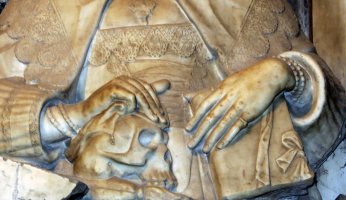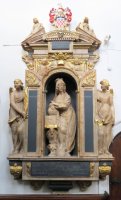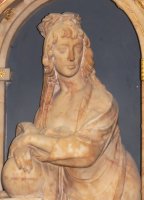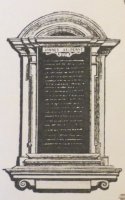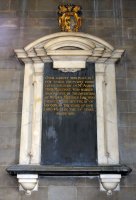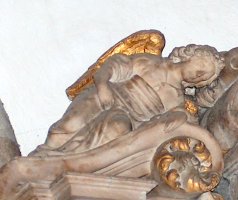Edward Marshall (1597/8-1675)
Edward Marshall was a 17th Century British sculptor who designed a number of surviving church monuments, and in the 1650s worked on a number of grand residences as a mason: Northumberland House in the Strand, Syon House and Gunnersbury House in West London, and a vast Hampshire mansion called The Vyne, a little outside modern Basingstoke. For most of his working life his sculptor’s yard was in the City, first in Fetter’s Lane by St Dunstan in the West, where for a time he supervised repairs to that church (previous to the current one on the site) and afterwards a few minutes stroll away in Whitefriars Street. He was a member of the Masons Company, acting as Warden and then Master in the 1640s, and from 1660 was appointed as Master Mason in the Office of Works, a position which previously had been held by Nicholas Stone the Elder.
The Curwen monument.
There are just a dozen or so of monuments signed by Edward Marshall, or proven to be by him, and a rather larger number which have been attributed to him at various times; however Adam White, the careful historian of early tomb makers, put the number of convincingly attributable monuments, including the proven ones, at less than 50. These include a few very large ones, such as that to the Earl of Totnes, in Stratford upon Avon, with a recumbent effigy and an outsize canopy with standing figure sculpture above and a relief of cannons, ammunition and gunpowder below, and to Mary Barkham, in All Hallows Church, Tottenham. His Westminster Abbey monument to Michaell Draiton [Michael Drayton], is a size down, with a bust above a framed panel; and he has a number of the ‘fireplace’ design panels with a wide border, upper and lower shelves, and a complex pediment at the top where most of the sculptural decoration lies.
Typical smaller design by Edward Marshall.
Edward Marshall had numerous children with his wife Anne [James], nearly all of whom predeceased him, and their mother dying in 1673. Edward Marshall died two years later, having married a second time, to Margaret, and leaving her and one son, Joshua Marshall, who became an important sculptor in his own right. One of his apprentices, Thomas Burman, also became a sculptor of some repute, though his known works are few. The Marshall family monument survives today, in St Dunstan in the West, kept along with many other monuments from the old church.
Angel from the top of a piece by Marshall.
